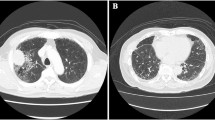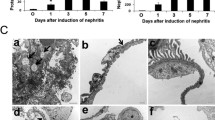Abstract
Background
Mesangial proliferative glomerulonephritis is a common glomerular disorder that may lead to end-stage renal disease. Epidermal growth factor (EGF) plays an important role in the regulation of cell growth, proliferation, and differentiation and in the pathology of various renal diseases. Erlotinib is a novel, oral, highly selective tyrosine kinase inhibitor of the EGF receptor. It is clinically used to treat non-small cell lung and pancreatic cancers. Here, we investigated the effect of erlotinib on the progression of mesangioproliferative glomerulonephritis in an experimental model.
Methods
Mesangial glomerulonephritis was induced with anti-rat Thy-1.1 antibody in male Wistar rats weighing 150–160 g. Rats were treated with erlotinib (10 mg/kg/day p.o.) or vehicle only (polyethylene glycol). Native Wistar rat kidneys were used as histological controls. Serum creatinine levels were measured at day 7. Kidneys were harvested 7 days after antibody administration for histology.
Results
Native controls showed no histological signs of glomerular pathology. In the vehicle group, intense glomerular inflammation developed after 7 days and prominent mesangial cell proliferation and glomerular matrix accumulation was seen. Erlotinib was well tolerated and there were no adverse effects during the follow-up period. Erlotinib significantly prevented progression of the glomerular inflammatory response and glomerular mesangial cell proliferation as well as matrix accumulation when compared with the vehicle group. Erlotinib also preserved renal function.
Conclusion
These results indicate that erlotinib prevents the early events of experimental mesangial proliferative glomerulonephritis. Therefore, inhibition of the EGF receptor with erlotinib could prevent the progression of glomerulonephritis also in clinical nephrology.




Similar content being viewed by others
References
Levy M, Berger J (1988) Worldwide perspective of IgA nephropathy. Am J Kidney Dis 12(5):340–347
Emancipator SN, Lamm ME (1989) IgA nephropathy: overproduction or decreased clearance of immune complexes? Lab Invest 61(4):365–367
Couser WG (1993) Mediation of immune glomerular injury. Clin Investig 71(10):808–811
Holbro T, Hynes NE (2004) ErbB receptors: directing key signaling networks throughout life. Annu Rev Pharmacol Toxicol 44:195–217
Wetzker R, Bohmer FD (2003) Transactivation joins multiple tracks to the ERK/MAPK cascade. Nat Rev Mol Cell Biol 4(8):651–657
Watanabe T, Barker TA, Berk BC (2005) Angiotensin II and the endothelium: diverse signals and effects. Hypertension 45(2):163–169
Mezzano SA, Ruiz-Ortega M, Egido J (2001) Angiotensin II and renal fibrosis. Hypertension 38(3 Pt 2):635–638
Kasselberg AG, Orth DN, Gray ME, Stahlman MT (1985) Immunocytochemical localization of human epidermal growth factor/urogastrone in several human tissues. J Histochem Cytochem 33(4):315–322
Harris RC (1991) Potential physiologic roles for epidermal growth factor in the kidney. Am J Kidney Dis 17(6):627–630
Harris RC, Hoover RL, Jacobson HR, Badr KF (1988) Evidence for glomerular actions of epidermal growth factor in the rat. J Clin Invest 82(3):1028–1039
Norman J, Badie-Dezfooly B, Nord EP, Kurtz I, Schlosser J, Chaudhari A et al (1987) EGF-induced mitogenesis in proximal tubular cells: potentiation by angiotensin II. Am J Physiol 253(2 Pt 2):F299–F309
Okada H, Danoff TM, Kalluri R, Neilson EG (1997) Early role of Fsp1 in epithelial-mesenchymal transformation. Am J Physiol 273(4 Pt 2):F563–F574
Creely JJ, DiMari SJ, Howe AM, Hyde CP, Haralson MA (1990) Effects of epidermal growth factor on collagen synthesis by an epithelioid cell line derived from normal rat kidney. Am J Pathol 136(6):1247–1257
Terzi F, Burtin M, Hekmati M, Federici P, Grimber G, Briand P et al (2000) Targeted expression of a dominant-negative EGF-R in the kidney reduces tubulo-interstitial lesions after renal injury. J Clin Invest 106(2):225–234
Flamant M, Bollee G, Henique C, Tharaux PL (2012) Epidermal growth factor: a new therapeutic target in glomerular disease. Nephrol Dial Transplant 27(4):1297–1304
Cappuzzo F, Ciuleanu T, Stelmakh L, Cicenas S, Szczesna A, Juhasz E et al (2010) Erlotinib as maintenance treatment in advanced non-small-cell lung cancer: a multicentre, randomised, placebo-controlled phase 3 study. Lancet Oncol 11(6):521–529
Moore MJ, Goldstein D, Hamm J, Figer A, Hecht JR, Gallinger S et al (2007) Erlotinib plus gemcitabine compared with gemcitabine alone in patients with advanced pancreatic cancer: a phase III trial of the National Cancer Institute of Canada Clinical Trials Group. J Clin Oncol 25(15):1960–1966
Bollee G, Flamant M, Schordan S, Fligny C, Rumpel E, Milon M et al (2011) Epidermal growth factor receptor promotes glomerular injury and renal failure in rapidly progressive crescentic glomerulonephritis. Nat Med 17(10):1242–1250
Wada Y, Iyoda M, Matsumoto K, Shindo-Hirai Y, Kuno Y, Yamamoto Y et al (2014) Epidermal growth factor receptor inhibition with erlotinib partially prevents cisplatin-induced nephrotoxicity in rats. PLoS One 9(11):e111728
Rintala JM, Savikko J, Palin N, Rintala SE, Koskinen PK, von Willebrand E (2014) Epidermal growth factor inhibition, a novel pathway to prevent chronic allograft injury. Transplantation 98(8):821–827
Savikko J, Rintala JM, Rintala S, Koskinen P (2015) Epidermal growth factor receptor inhibition by erlotinib prevents vascular smooth muscle cell and monocyte-macrophage function in vitro. Transpl Immunol 32:175–178
Ikezumi Y, Kawachi H, Toyabe S, Uchiyama M, Shimizu F (2000) An anti-CD5 monoclonal antibody ameliorates proteinuria and glomerular lesions in rat mesangioproliferative glomerulonephritis. Kidney Int 58(1):100–114
Tomita M, Sogabe H, Nakazato S, Nakatsuji S, Noto T, Hamada K et al (2005) Monoclonal antibody 1-22-3-induced glomerulonephritis in uninephrectomized rats as a model of progressive renal failure. Nephrol Dial Transplant 20(11):2358–2367
Acknowledgments
This work was supported in part by Finska Läkaresällskapet, the Finnish Medical Foundation, Helsinki University Hospital Research Funds, the Research and Science Foundation of Farmos, Research Funds of Päijät-Häme Central Hospital, and the Academy of Finland.
Author information
Authors and Affiliations
Corresponding author
Ethics declarations
Conflict of interest
The authors have no conflicts of interest to disclose.
Ethical approval
All applicable international, national, and/or institutional guidelines for the care and use of animals were followed.
Rights and permissions
About this article
Cite this article
Rintala, J.M., Savikko, J., Rintala, S.E. et al. Epidermal growth factor receptor inhibition with erlotinib ameliorates anti-Thy 1.1-induced experimental glomerulonephritis. J Nephrol 29, 359–365 (2016). https://doi.org/10.1007/s40620-015-0233-x
Received:
Accepted:
Published:
Issue Date:
DOI: https://doi.org/10.1007/s40620-015-0233-x




